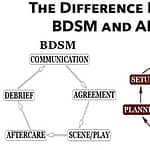In the summer before college, I dated a man from my hometown who’d go on to become my rapist. In the beginning, the relationship was consensual and exciting. He was a surfer and general thrillseeker, tan and muscular with broad shoulders. A few years older than me and confident to a fault, he pushed me in ways I enjoyed at first.
I remember climbing a 150-foot tree with him one day in spite of my crippling fear of heights. About a third of the way up I froze, shaking and clutching a branch on the verge of tears, and told him, “I can’t go further. I’m not even sure I can get back down. I’m scared.” He looked at me with his wide, sky-blue eyes and nodded, smiling. “I know you are. I can see it. But you’re getting to the top of this tree. I’m going to help you.”
And he did. We made it to the top and swayed in the breeze while watching the sunset before coming back down. I felt accomplished and ridiculously attracted to him for patiently leading me through the task. This was all before I understood BDSM, but not before I developed a taste for those types of experiences. When it comes to romantic relationships, I’ve always had a thing for dominant personalities.
He was the second man I’d ever allowed inside me, which made the relationship feel important at the time. He’d fuck me hard while squeezing my throat and whispering possessive things in my ear. “Now you’re mine. Do you fucking hear me?” I couldn’t tell whether he was serious or just talking dirty and didn’t love myself enough yet at the age of 18 to care. All I knew was that it turned me on.
As you might expect, although I didn’t at the time, he pushed my limits until he finally went too far. I woke up one morning to him sliding inside me without a condom, which he knew was a no-go. Pissed off and shocked, I struggled against him, telling him to stop and trying to get him out of me. He held me down and kept going, laughing while he did it. He raped me as if the situation were something as trivial as a tickling match.
After he finished, I sobbed and screamed at him until I went hoarse, overcome by the most blinding rage I’ve ever felt in my life. Cocky and still smirking, he observed my meltdown and informed me that if I couldn’t handle it, I was free to leave. I picked up my shit and drove home shaking in anger. The event brought an abrupt end to the relationship.
I wish I could say that was the only time I experienced abuse or sexual assault while growing up kinky, but it wasn’t. I reached my 30s before finally figuring out how to seek out the right partners and approach BDSM in ways that were safe. To explore my sexuality, I’d need partners who were almost overly concerned about respecting boundaries instead of ones who got off on pushing limits, like the people in my fantasies.
I think a lot of kinksters experience similarly messy challenges during their journey. We have to figure out how to navigate our fetishes in ways that keep everyone safe, respected, and able to say no. This takes time and experience, as the topic remains taboo and is generally absent from sex ed. It’s easy to find oneself in a few toxic relationships along the way.
If you’re kinky and are experiencing similar problems, you might be wondering whether it’s even possible to practice BDSM in ways that are sustainable. I’m here to assure you that, with a healthy perspective and great partners, you absolutely can.
I had a codependent pattern of choosing abusers, partially due to my fetish for masochism. Here are some tips that helped me break free and learn to approach BDSM safely.
If You Care Please Help To Share
Consider seeing a kink-friendly psychologist
When I was younger, I used to hate it when I’d talk about my trauma and friends would suggest therapy. It felt like a cop-out, like they were passing the buck after offering to support me. (And speaking of bucks, therapy money doesn’t exactly grow on trees.) Of course, my friends were wonderful, but not at all qualified to guide me through my deep-seated emotional issues. I didn’t realize that my expectations of them were both unfair and unrealistic.
After yet another terrifying relationship shattered my ability to function a few years back, I ran out of choices. I felt like encountering another man who ran roughshod over my boundaries might kill me. I just wanted to be in love like everyone else and my search for it was ruining my life. I needed to talk with a professional.
During an early session with the therapist I found, I wanted to talk about my ex and his rage issues, but she wanted to talk about my family. She asked me to list each member and drew a corresponding tree on a blank sheet of paper while I talked. She then asked me to describe each person with three adjectives. When I’d finished, she turned the illustration around and showed it to me. “Notice anything about how you describe the men in your family?”
Serious. Stubborn. Scary. Rude. Defensive. Close-minded. Insulting. Arrogant. Disrespectful. Temperamental.
They weren’t all necessarily abusive people, but I’d been afraid of them due to their messy and very human coping mechanisms. I stared down at the thing before looking up at her. “You think this is why I choose men who treat me badly?”
“It has more to do with what you consider normal. You’re more likely to excuse or try to fix that kind of behavior when you’re used to being surrounded by it.” Apparently, my willingness to tolerate bullshit from partners was far too high, and beyond that, unnecessary. “You’re not obligated to put up with abuse from someone just because they love you. You deserve happiness as much as anyone else. You can always walk away,” she asserted.
Still, I worried about my fetishes and whether they would doom me to a lifetime of dysfunctional relationships. I loved BDSM and wasn’t willing to give it up. Some of my most intimate and transformative experiences had happened during play over the years. Additionally, I feared I’d lose all connection with my sexuality without kink. Vanilla dynamics didn’t do it for me.
“What do you think about the S&M stuff?” I asked her. “Do you think it’s unhealthy?”
“Does it feel unhealthy?”
“No. It feels amazing, actually, when my partners care about my boundaries.”
“That makes sense. Sounds like you’re on the right track then,” she said in that mysterious, ‘follow-the-breadcrumbs’ way therapists speak when they’re trying to guide you toward an epiphany. “Sexual desires like yours are pretty common.”
I had expected therapy to feel disempowering, but it ended up being a game-changer. I’d recommend it to anyone struggling with toxicity in their relationships. Though my psychologist had been open-minded, I don’t think she’d been fully equipped to guide me through the nuanced learning required for BDSM. It’s best to specifically seek out a kink-friendly therapist, when possible.
At the very least, if you think you’d benefit from therapy, try to find a counselor who won’t shame you for your desire for consensual kink, as piling more shame on your plate won’t help you. A qualified psychologist trained in the U.S. will understand the difference between a paraphilia (an alternative sexual interest) and a paraphilic disorder (an alternative sexual interest that’s problematic), as the American Psychiatric Association notably depathologized kinky sex in the DSM-V in 2013.

Click Here To Better Understand The Difference Between BDSM And Abuse
BDSM is meant to enhance and strengthen a healthy, loving relationship. Learn the keys to a healthy Dominant/submissive relationship and avoiding abuse in your future relationships.
Forgive Yourself
It took me over a decade to stop blaming myself for choosing the man who would become my rapist. I had a million reasons in my mind for why my trauma was either my fault or illegitimate.
His personality appealed to my kinks. It was my fault for being attracted to power play. I should’ve fucking known better.
He was my boyfriend and I’d had consensual sex with him before. People have told me you can’t get raped by your partner.
I let him fuck me within a few weeks of starting to date. I should’ve waited longer. Maybe he would’ve valued me more if I did.
In reality, none of those things were true. His violence was his own choice, not mine. I didn’t have the knowledge or words for it, but I’d wanted consensual kink, not sexual assault. He and I hadn’t discussed anything related to BDSM, like negotiation or safewords. “No” meant no, and he had no reason to believe otherwise. I didn’t want, ask for, or deserve what he eventually did to me and he hadn’t done it for the sake of my pleasure.
If rape or abuse has happened to you, you may be blaming yourself for it like I did. Perhaps you believe your desire for power exchange is a curse or puts you in a position where you’d be deserving of mistreatment, were it to occur.
No one is inherently deserving of abuse, and certainly not for liking kinky sex. Whatever trauma ran a tornado through your life was not your fault. Keep this in mind and make it your mantra.
Analyze what appealed to you about past abusive partners.
No one consciously seeks to build a life with someone who’ll habitually mistreat them and make them miserable. If your abuser was a partner you chose to date, they must have had some positive qualities that attracted you to them in the beginning.
Perhaps they were charming, confident, ambitious, capable, responsible, excited to lead you through new or challenging experiences, or indulged your desire to give up control. Such traits are often appealing to folks who enjoy bottoming. If topping is your cup of tea, perhaps they were demure, vulnerable, submissive in bed, thrilled to follow your lead, keen to validate your desire to provide, or a combination of other qualities.
There’s nothing wrong with liking those traits. You can seek them out in future relationships while steering clear of people who display red flags. (More on that later.)
One thing I commonly hear from tops, bottoms, and switches alike is a desire for INTENSITY in their relationships. I remember a kink-curious friend once telling me about how he’d broken up with a past girlfriend because the relationship had felt too peaceful and therefore boring. “We never fought. Not once, about anything. Everything was always just so lukewarm and fine all the time. I wanted a bit of conflict and drama. I wanted to explore other emotions with her.”
I smiled. “Sounds like you’re kinky, dude. I can relate.”
Abusive partners fulfill these sorts of existential yearnings for a time because they tend to be intense people, which makes them noticeable and exciting in the beginning. But we can’t be sacrificing our happiness or safety for the sake of the rush and we truly don’t have to. We can explore whatever headspace we want during kinky play while holding down a peaceful and ultra-respectful relationship outside of it, if we’re smart.
If you haven’t already, read up on the basics of BDSM ethics.
“BDSM,” as it’s defined within our subculture, must be done safely, sanely, and consensually to be acceptable. Anything else would be reckless or abusive. This sounds straightforward enough, but requires far more knowledge, communication, and empathy than I anticipated when I was younger.
Reading up on BDSM best practices can help you understand what kind of behavior is or isn’t healthy within a kinky dynamic. For instance, all parties need to have equal say over what does and doesn’t happen during play. No one, whether topping or bottoming, should feel coerced into anything they don’t want to do. And if you want to dive in beyond light dabbling, BDSM takes planning, negotiation, aftercare, and effective safeword systems.
Responsible partners will appreciate and understand all this. If they don’t, or they’re not at least willing to learn, it’s best to back away. Anyone who thinks negotiation is a waste of time, for example, isn’t ready for BDSM.
Be on the lookout for red flags
The best way to avoid abuse is to steer clear of people with abusive beliefs, behavioral patterns, or ways of thinking. Once you have a filter for people with these problems, you’ll be less likely to fall for their bullshit while seeking out partners.
Be extremely picky about who you practice BDSM with. These are the red flags I try to avoid these days:
- People who are willfully racist, sexist, classist, homophobic, or bigoted in some other way. I don’t want anyone so lacking in empathy to be in charge of my safety.
- People who find pleasure in pushing hard boundaries, and not just during sex or play. People who regularly provoke arguments or burn bridges with others, for instance, tend to be problematic.
- People with anger problems. Eventually, they’ll turn their anger on you, and not in play-focused ways that are fun, sexy, or safe.
- People who have trouble communicating, especially about their feelings. None of us are mind readers and BDSM becomes dangerous if you can’t talk about it.
- People who are self-centered. I want partners who understand that kinky play is about collaboration and want me to have an equally enjoyable time.
- People who are dishonest. I need partners I can trust beyond the shadow of a doubt.
- People who use BDSM to feed emotional problems. For example, if your partner is attracted to submission because they’re truly dependent or believe themselves to be worthless, you’re headed for a toxic situation. Same goes for doms who use topping to compensate for their insecurities.
- People who push to play or get into a relationship too quickly. Pushiness signifies a lack of reverence for boundaries. Play with people who respect your pace and comfort level.

Click Here For More Red Flags To Avoid With Potential Dominants
Choosing the Dominant that you want to serve is a serious decision. One that is taken far too lightly but in fact should not be. Making yourself mentally and physically vulnerable to the wrong person can have terrible repercussions. Learn about the types of Dominants you should avoid and the types of Dominants that have your best interests at heart.
- They have a desire to deeply understand you and discover how your body and mind work. This will help them collaborate with you to co-create fantastic experiences.
- They can separate fantasy from reality. The dominant or submissive roles they explore during play don’t get in the way of their ability to play safely, sanely, and consensually.
- They respect your boundaries without question and back off immediately when you lay them out. This shows that your enjoyment is important to them.
- They’re truly kind at heart, no matter how mean or disrespectful they might act during play.
- They’re excellent communicators.
- They take things like negotiation, safewords, and aftercare seriously and are enthusiastic about participating in those processes.
- They’re qualified to do the activities they want to try during play. For instance, if they want to tie you up, they’ve studied how to do so in ways that protect your safety.
Consider getting involved in your local kink community
I know a fair amount of people who prefer to keep their fetishes in the bedroom and I understand why. However, if you live in a biggish or relatively progressive city, chances are there’s a BDSM scene there. You might benefit from the support of other practitioners. If you’re lucky, things like munches, classes, discussion groups, and play parties will be readily available.
Exploring the kink scene allows us to meet potential play partners in a safer setting than, say, meeting a stranger from the internet in a hotel room or other private venue. It’s harder for people to get away with shady behavior in a community where safety and reputation are everything. This provides an element of accountability.
It’s worth noting, however, that the quality of the kink scene in any particular area will depend on the local culture, the organizers who run events, and the attitude of participants. There will always be people with unhealthy intentions, habits, or personalities attracted to these communities. It’s up to consent-loving folks to protect one another from predators.
If you do decide to dive in, take your time, ask questions, and trust your gut. Pass up any events by organizers who don’t make everyone’s safety their first priority.
Negotiate in detail
There are people who fear that talking about BDSM in advance will ruin the magic. This couldn’t be further from the truth. Bad surprises, crossed lines, and misunderstandings about consent ruin the magic. Negotiation is foreplay and a major tool for ensuring everyone has a good time. Don’t be shy about discussing what you do or don’t want to experience. Any compatible partner worth playing with will want to hear about the ins and outs of your fantasies.
I think it’s also worth it to talk about any fears you might be holding onto in relation to negative past experiences. Your new play partners aren’t responsible for that baggage, but they’ll want to know where you’re coming from if they care about you and wish to earn your trust. They certainly won’t want to risk retraumatizing or triggering you during play. And on the flipside, don’t forget to hold space for your partner to talk about their own worries or trauma when they’re ready to open up and talk about it.
Communicate your needs during play
A huge part of recovering from abuse is becoming comfortable communicating your feelings, needs, and boundaries according to what YOU want rather than what your partner wants. Don’t just go along with whatever you think you should be doing. Whether you’re topping or bottoming, feel empowered to speak up if things start to take a turn that doesn’t work for you. It’s your sexuality and you have a right to reclaim it.
The most challenging thing about safewords is learning to use them when you should, which is whenever the fuck you feel like it. Don’t worry about ruining your partner’s good time or disappointing them. Pay attention to how you feel and know that it’s fine to pause or end play at anytime. Ethical partners will be dying for you to state your boundaries and have trouble trusting you if you can’t. Anyone who gives you shit about your boundaries is likely to become increasingly problematic.
When you run into challenges, remember that your new partner isn’t the person who abused you
We learn from our negative experiences so we can avoid making the same mistakes in the future, which is essential. However, no relationship is perfect and you’ll definitely hit snags with any play partner, especially in the beginning. When you do, you might get paranoid and want to run, anticipating all the same pain and fights of the past.
It’s wise to be willing to walk away if things aren’t going well or a new partner does something horrible. But keep in mind, you’re dealing with an entirely different human being with different beliefs, intentions, and experiences than those of your past abuser or rapist. Do your best to be fair during tough times. Try not to get defensive unless the situation actually merits it.
Write new stories over your old ones.
You might still be telling yourself that you’re a victim or the type of person others will always take advantage of, or that your trauma will forever cast a shadow on your sexuality. None of this has to be true. You are in control of your future.
We don’t choose to be victims of crime or mistreatment, but we may choose to stay victims by holding onto the past and using it to define ourselves. The story of your life doesn’t have to be hijacked by what happened to you. Rewrite your narrative so you can finally find peace and enjoy yourself. Today is a new day.
Rape and abuse are disturbingly common. Most people I know, including myself, never completely get over those experiences and it’s fine if this is also true for you. You’re not alone. None of it has to stop you from exploring consensual kink. There are incredible play partners out there waiting to meet you and others who’ll be happy to support you along the way. Don’t be afraid.

By Molly Lazarus
Molly Lazarus is a sex blogger, kink educator, and erotic fiction author. Her website, Kink Out Loud, serves as a resource for readers who are curious about BDSM or new to the practice. Offline, Molly acts as Volunteer Coordinator for the Bay Area chapter of Kinky Salon. You can follow her on Facebook and Pinterest, or browse her fiction on Amazon.
Copyright 2008-2024 BDSMTrainingAcademy.com
By reading and accepting this article you agree to all of the following: You understand that this is simply a set of opinions, personal experience and anecdotal evidence (and not advice). You are responsible for any use of the information in this article, and hold BDSMTrainingAcademy.com and all members and affiliates harmless in any claim or event.
You must be 18+ years old to read this blog
Related Posts

BDSM Protocols: Part 1 – Introduction
I feel like the least-likely guy on the Earth to w...

The Obsession with Spanking Scenes In Film
“Spanking, Always Up For A Bit of Spanking!” ...

The Difference Between BDSM And Abuse
I continually receive emails and comments at The B...








